Onboarding a new client?
Hiring a new freelance writer?
Great.
You’ll need a freelance writing agreement in place to protect yourself either way.
Otherwise, you’re both at risk of non-payment, not receiving deliverables, and hurting your businesses.
And you don’t want that!
I’ve been copywriting for eight years and having a contract in place is one of the most important steps in my process.
Don’t know how to create a writing contract or what to look for?
No problem.
I’ll teach you ahead. 👇
What is a freelance writer contract?
A freelance writing contract is a legal document that details the responsibilities of both parties (the writer and client) during a project.
The agreement also covers payment details, legal rights, copyrights, termination, and more.
Often they are riddled with legalese that only a Wall Street lawyer could decipher.
Seeing as 35% of freelancers believe they get scammed because of poor contracts, it’s a step you can’t overlook, however.
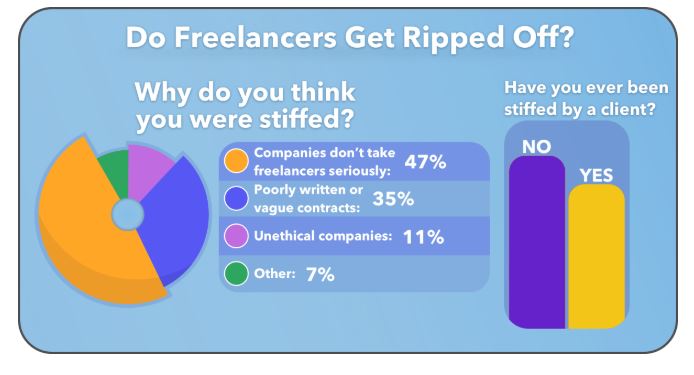
Writing contracts prevent miscommunication and errors, especially once you’re working with another business for a long time.
Ideas, payments, and rules can be lost in the mix.
Let me tell you a story…
I onboarded a new client and we agreed upon my normal rates, process, etc.
However, once I delivered the first month of content, they thought it was for free… 👎
Nope.
While the first thing that went through my head was “I hope they’re not trying to scam me,” it ended up being an honest mistake.
I referenced back to our contract and payment was received. 🙂
Should you do freelance writing without a contract?
That’s like driving a car without a seatbelt.
It’s right there and can save you, so why not use it?
A freelance writing contract doesn’t take long to write or customize. I’m giving you a free template later in this article to save you heaps of time, too.
It will give you peace of mind, shows you’re professional, and in the worst-case scenario, you’re protected legally.
On the flip side, if you’re hiring a copywriter, definitely have a contract in place for the same reasons.
This ensures you get deliverables, pay the correct rates, etc.
In fact, you should never work without one. It’s simply asking for trouble.
If a writer or client refuses to sign a document, run for the hills. That’s bad news bears.
Next, let’s talk about how to write a freelance writing contract.
How to create freelance writing contracts
These are the steps you should take, and I have, to create safe and thorough writing contracts with clients or freelancers.
Let’s dive in.
Step 1: Use a document signing app
While you could go old school and use a fax machine (people still use those, right?), technology is your friend.
Instead, use a document signing app to create agreements and collect electronic signatures—all while in your pajamas!
One I recommend is DocuSign. They have a free 30-day trial you need to try out here.
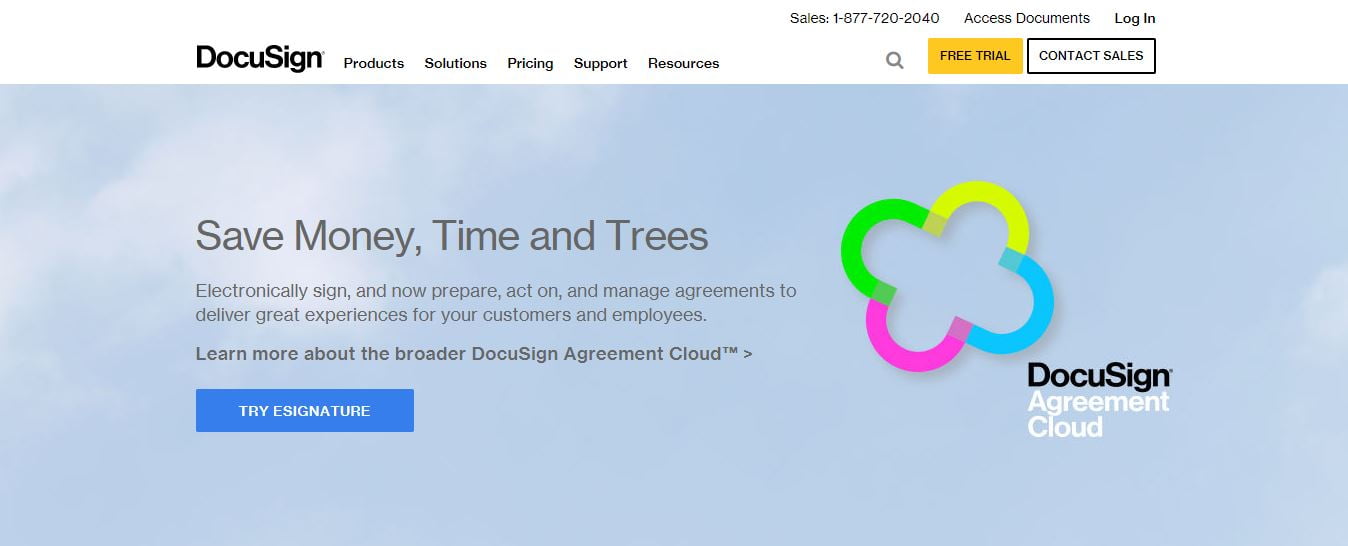
Click “Free Trial” and fill out the registration form on the next page.
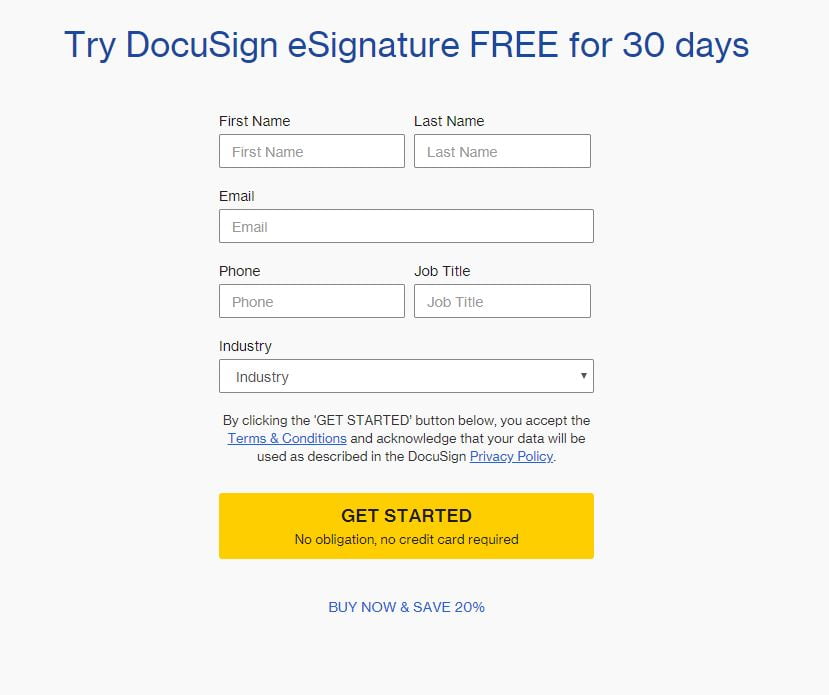
Click the “Templates” tab from the dashboard and upload a template after signing up.
Then, set the name of the placeholder field for clients to sign.
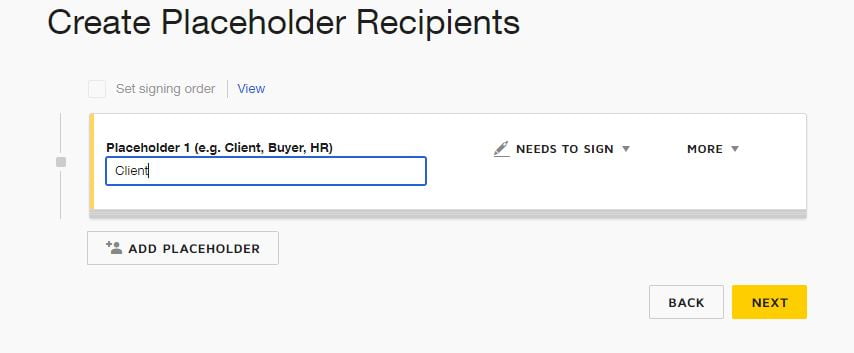
Add their name and email under the “More” dropdown menu.
Next, add a signature and date field at the end of the agreement.
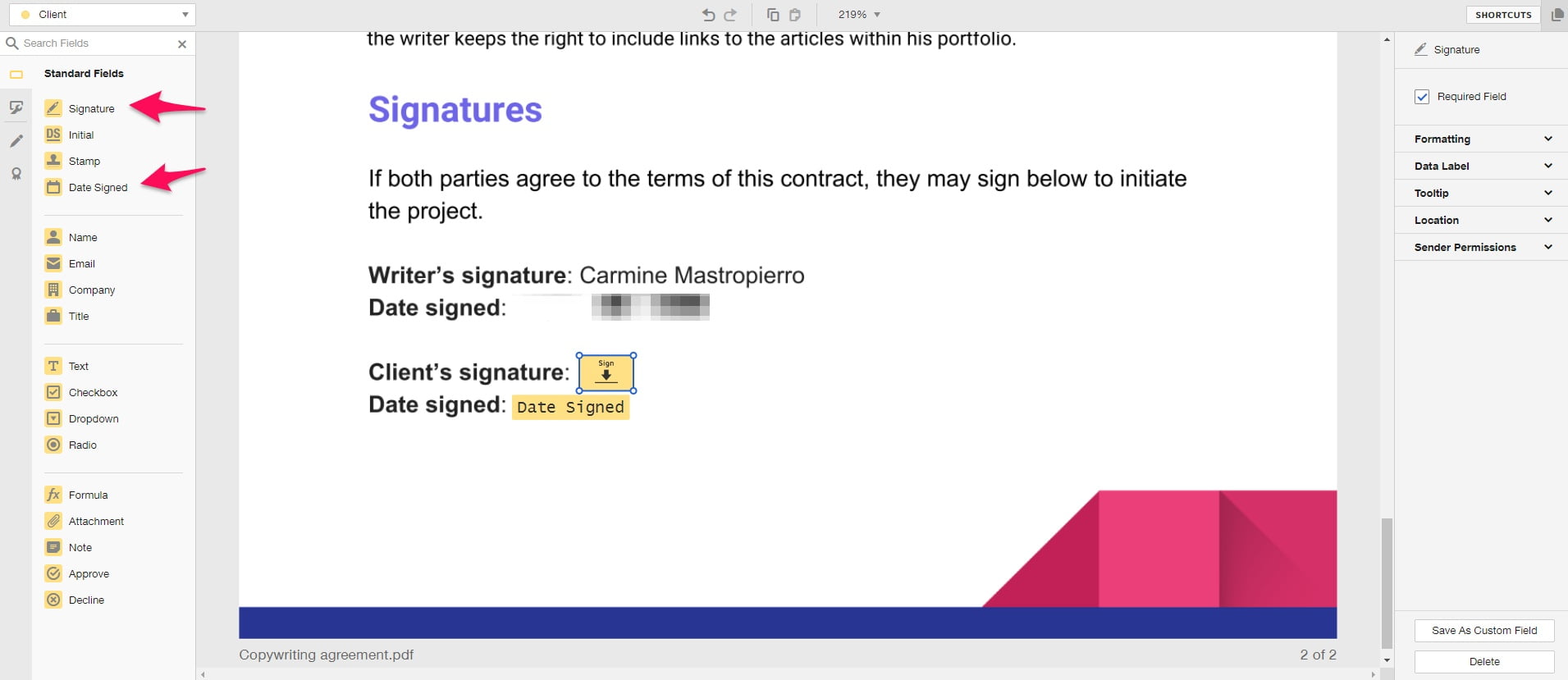
Click the “Next” button on the bottom right of the screen and you will be able to save your template for future use.
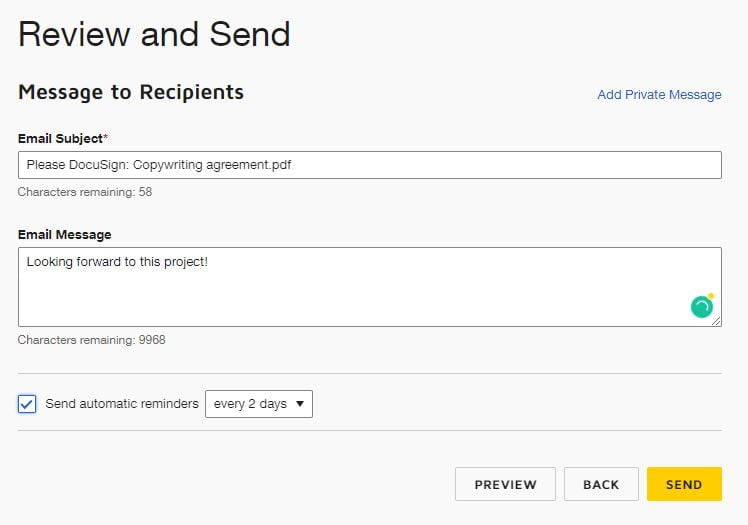
Finally, review and send the contract to get the party started!
Step 2: Include the most important sections
Let’s touch on the different sections that a copywriting contract should have to keep you and the client protected.
Introduction
The first section is an introduction. Think of it like an executive summary or cover letter.
It sums up the project, the parties, and what’s expected out of both of them.
Typically it will use terms like “Client” and “Writer” to address both groups.
It may look like this:
John Doe (Also known as “Writer”) will provide Microsoft (Also known as “Client”) monthly blog posts for the official Microsoft blog. The below contract summarizes the requirements and roles of both the Writer and Client. If both parties sign this agreement, they agree to all of the terms and conditions.
The introduction can be a single paragraph or several depending on the complexity of the project.
I also recommend stating the date in which the project will start once the agreement is signed.
Scope of work
This is one of the most crucial parts of a freelance agreement.
It describes the exact type and amount of work you will provide for the client.
Be very specific and thorough here. Don’t write something vague like “The writer will provide blog posts.”
That means nothing.
Instead, include something like:
Writer agrees to provide the Client the following deliverables each month:
1. Four 1,000 word blog posts.
2. Three headline ideas per blog post.
3. One title tag, URL, and meta description per blog post.
Furthermore, be careful guaranteeing any results within a contract. You’re increasing the chances of getting yourself in legal trouble.
At the end of the day, results aren’t guaranteed.
That’s like me telling my content writing clients I’ll 100% get them 50,000 visitors per month.
Sure, I’ll generate them leads, traffic, etc. But I can’t guarantee a number. (If only I had a crystal ball…)
This section is also very important because of a phenomenon known as scope creep.
Let me ask you this: have you ever performed work for somebody, then you gradually offered more and more services outside of the original agreement?
Perhaps you were writing more content, doing social media, and random tasks.
It happens to all of us. And, a good contract will prevent it from happening.
In the case that you do end up providing extra work, you can safely charge them and reference the contract.
Revisions
Unless you’re the Michael Phelps of writing, there’s going to be edits, revisions, and changes done to the material you provide.
This section will describe how revisions are handled.
Some writers include a certain amount of revisions within their pricing while others charge a separate fee.
Once again, this prevents mishaps and makes the project expectations more clear.
I find that most clients are honest and easy to work with.
However, it’s possible to get stubborn clients who are perfectionists. In that case, you’ll be very happy that you made a revisions section within the agreement.
This part may look include writing like:
The Writer agrees to offer one round of revisions once the blog posts are delivered through Google Drive to Microsoft’s editor.
However, extra revisions will be charged at a rate of $50/hour USD.
That brings me to my next point.
Payment
You deserve to get paid for your hard work.
Trust me, I’ve had clients who are late to pay invoices or come up with excuses.
Nonetheless, a section of a freelance writing contract that covers payment details should ensure you’re paid every time. 💲
You have bills. Rent. Insurance. You need your money.
Lack of cash is the second most common reason businesses fail, too.
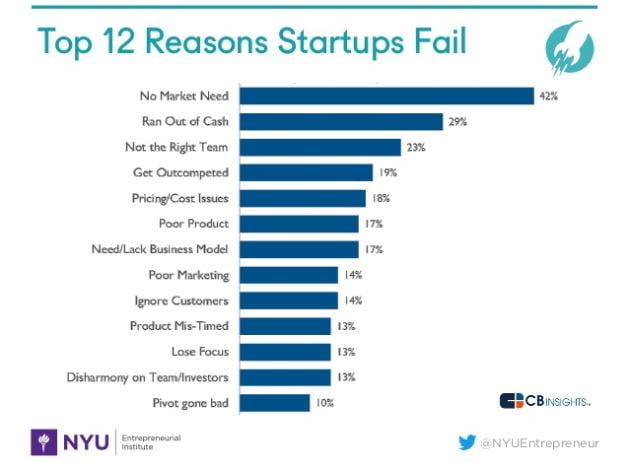
That’s why you need to clearly state in your agreement how much you are charging the client, how you will invoice, and when it must be paid.
In terms of when an invoice should be fulfilled, keep in mind that larger companies have accounting schedules and may not always be able to pay at a moment’s notice.
In that case, the payment section may look like this:
The Writer will invoice the Client on the first business day of every month for the previous months deliverables as outlined in this agreement.
Invoices will be sent through PayPal and must be paid within 14 days after the invoice is sent.
The Client agrees to pay a flat monthly rate of $1,000 for the agreed scope of work.
I firmly believe this section of an agreement is what will make your income more consistent.
If it’s vague and flexible, you could make a lot of money one month then little the next because of late payments.
Copyrights
Writing projects often include many different deliverables and items: graphics, research, articles, etc.
This is why it’s ideal to have a portion of the contract cover who owns what at different stages.
I’m a firm believer that you must always include a statement that says you retain the right to include the work in your portfolio and claim that you created it.
I’ve never had a client who didn’t mind this. They just don’t want the content or copy reposted, shared, etc.
That’s why a writing contract needs a line similar to:
Once the deliverables are published, the Client owns all of the copyright for such material.
The Writer retains the right to show the deliverables as portfolio pieces to future clients, on their website, social media, and other channels.
The Writer agrees that the deliverables can not be re-used in any other circumstance.
Legal
Things happen.
That’s business.
Hopefully, every project will be smooth as silk, but not all do, unfortunately.
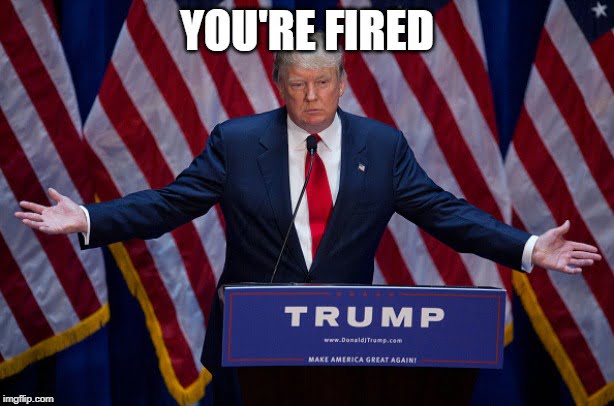
I’ve had a few bad apples myself.
Luckily, the legal area of a contract covers this.
Here’s the thing: I’m not an attorney so take this all with a grain of salt. It’s always best to consult with a legal professional to fully protect yourself and get the best advice.
Nonetheless, fleshing out this section protects you in the case of errors, damage, or non-payment.
It may appear like so:
The Writer can’t not guarantee any specific results from the deliverables, nor that they will be error-free. The Writer is not liable for any damages to the Client or third-parties related to the Client, either.
This agreement and all of its terms and conditions are governed under Federal and Provinicial law in Ontario, Canada.
Termination
Luckily I’ve never had to cut a contract short. But, it’s still good to have termination grounds.
These cover the circumstances that need to occur for the contract to be severed.
This normally includes:
- Non-payment
- Excessive scope creep
- Not receiving deliverables
- Breaking terms and conditions
- Etc.
But, I don’t want to spook you.
Terminations aren’t always bad.
Some times the client no longer has a need for the project or they’ve run out of budget.
I like to include a section that states both parties are welcome to back out of the contract at any time via written, email, or phone communication.
Payment and deliverables for that period of the agreement are still due, however.
Signatures
Last but not least, signatures!
If you followed the steps I laid out with DocuSign, this will take care of itself.
You want to have signatures for crucial parts of the agreement, especially at the end where you state both parties agree to all of the terms.
Some writers and companies include signatures in other important areas, such as payment, legalities, copyright, etc.
Step 3: Send away!
Presuming you used DocuSign or similar software, send the contract via email and the other party will be able to sign it online.
This will give you a finished version afterward with confirmation and you can officially begin the project!
Alternatively, you can fax or have the contract printed to be signed physically if you’re going to see the other party in-person.
Freelance writing contract template
I know, I know. It’s daunting, right?
Putting together a contract can be tough, so I wanted to give you a template that’s customizable.
Use this as a base and tailor it to each project.
Project name
Client: {Name, company, address, URL, contact information}
Writer: {Name, company, address, URL, contact information}
Date: {Date}
Project summary {Introduction to Client and Writer, deliverable overview, etc.}
Scope of work {What will be provided, how often, what deliverables look like, and turnaround time.}
Revisions {What revisions are included and the price for extra edits.}
Payment {How much the project costs, how invoices are being sent, and when they’re due.}
Copyright {Who owns what material and when the rights transfer over.}
Legal {Agreement to the terms and conditions and a statement of which law governs the contract.}
Termination {The grounds and process for the contract to be terminated.}
Signatures {Signature and date lines for you and client to sign.}
Final thoughts on freelance writer contracts
You don’t want to get stiffed or chase someone around for money.
The best way to avoid those situations? Use a contract.
I know that the legal side of writing isn’t everyone’s strong point.
Nonetheless, you need to have some form of legal protection in place.
While I am not a lawyer nor can I offer legal advice, use the template and information I gave you today as inspiration.
If you want to be completely safe, consult with an attorney to get a fully revised contract you can confidently use.
You can also check out my online courses to get coaching and a community of like-minded writers!














